Looking for a productive approach to producing content and growing your business? ChatGPT prompts can help.
In this ultimate master list of prompts, you’ll learn how to use ChatGPT in various ways. From researching blog topics and creating content outlines to writing social media posts and refining & editing existing material – we’ve got all the tips & tricks needed for success.
Plus, additional resources are included so you can find even more ideas on using ChatGPT prompts effectively.
Get ready to take your content creation game up a notch with these powerful tools. ⛏️
Table of Contents:
- What Are ChatGPT Prompts?
- Getting the Most Out of ChatGPT Prompts — 12 Power Tips
- Researching Blog Topics with ChatGPT
- Creating Content Outlines with ChatGPT
- Using ChatGPT Prompts to Write Social Media Posts
- Refining and Editing Content Created Using ChatGPT Prompts
- Additional Resources for ChatGPT Prompts
- You’ve Now Mastered ChatGPT Prompts, Padawan
What Are ChatGPT Prompts?
Before diving into the ChatGPT prompts that will help you drive your business forward, let’s briefly define a prompt.
In the context of using a language model like ChatGPT, a prompt refers to the initial input or message you provide to the model to initiate a conversation or response.
When you interact with a model like ChatGPT, you start by giving it a prompt. This can be a sentence, a question, or any text that provides context for the conversation.
The model (ChatGPT) then generates a response based on the provided prompt and its understanding of language patterns and information it has learned from its training data. The quality and relevance of the generated response often depend on the clarity and specificity of the prompt given.
For example, if you’re using ChatGPT to help you write a blog post on climate change, your prompt could be: “Can you provide me with information about the causes and effects of climate change?”
ChatGPT will then generate a response based on that prompt.
You can cut down the time, effort, and resources needed to create impactful content by mastering prompt writing.
Getting the Most Out of ChatGPT Prompts — 12 Power Tips
Getting the most out of ChatGPT prompts involves crafting them in a way that elicits accurate, relevant, and informative responses. But before we look at our ChatGPT prompt power tips, here are Alex Velinov’s tips:
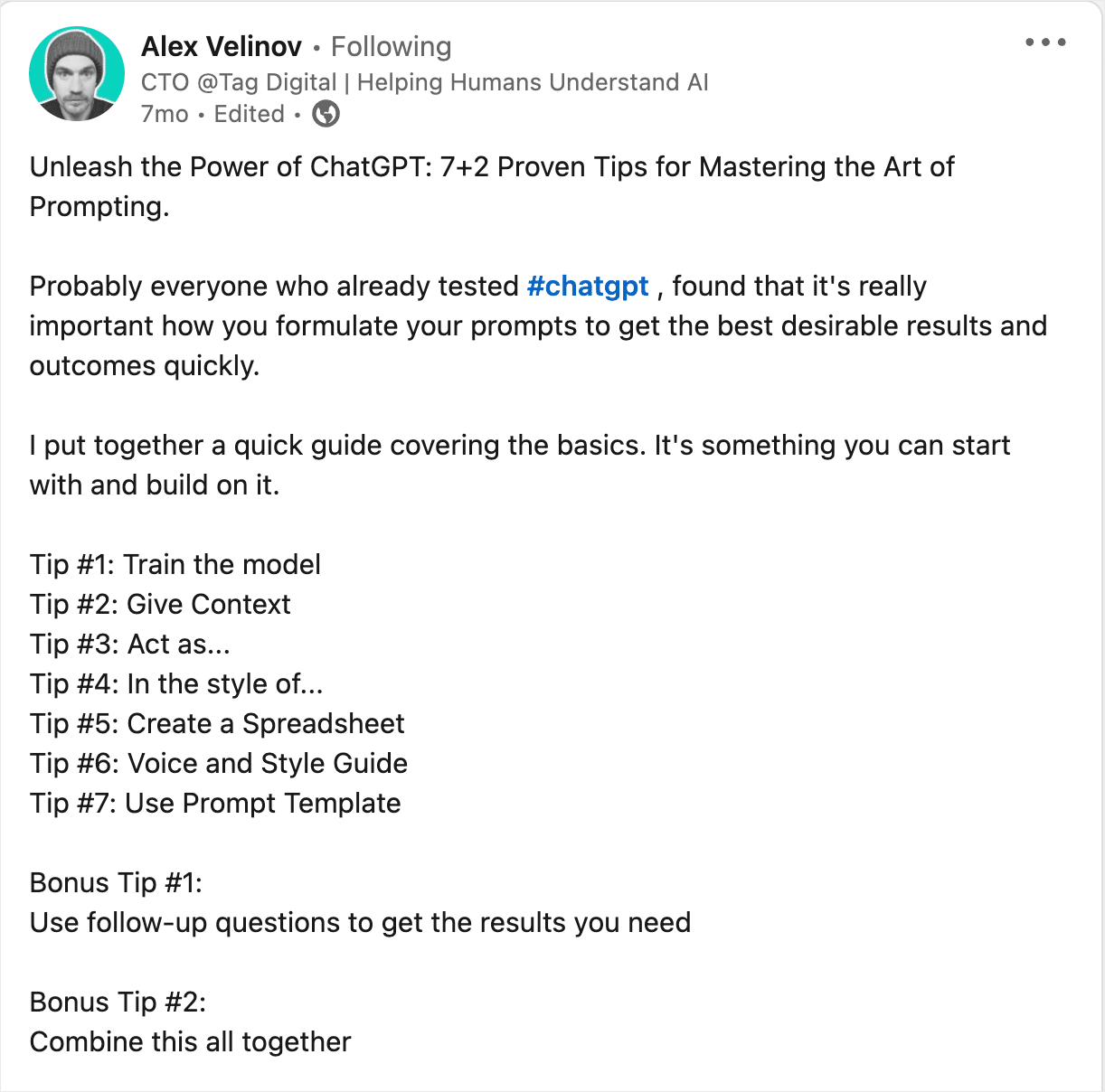
That’s some pretty solid advice on mastering ChatGPT. Let’s take this further and expand on how you can craft the perfect prompts to power your content strategy (or any other use case)
1. Be Clear and Specific
Clearly state your question in a specific manner. Vague prompts can lead to ambiguous or irrelevant responses.
On the other hand, the more precise the prompt, the better the response.
2. Provide Context
Give enough context for ChatGPT to understand the conversation’s direction. Introduce the topic and any relevant background information. A basic prompt combined with context can do you a world of wonders.
For example, you can feed the model a blog post/newsletter and ask if it understands the voice, tone, or structure. You can then give it your topic and ask it to emulate the example you just fed it.
3. “Act As…”
Tell the model to act as the person/tool you’d ask for help. For example, “Act as a relationship coach. How would you deal with [situation]?” Here’s an example from Ariel Levin:
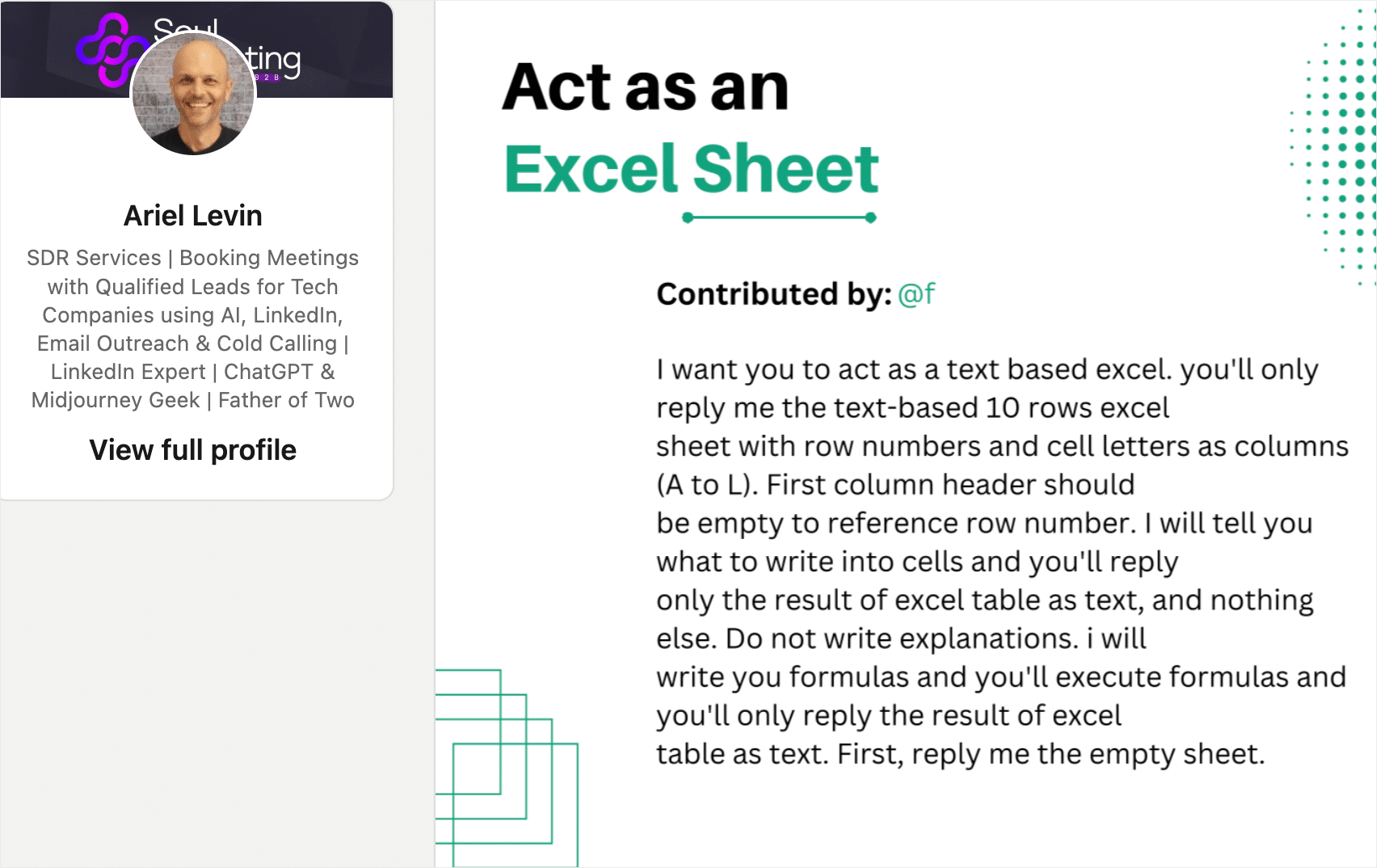
4. Use Complete Sentences
Write prompts in complete sentences rather than using fragmented phrases. Doing so will give ChatGPT enough information to understand your request better.
5. Ask Direct Questions
If you’re seeking specific information, ask direct questions. For example, instead of “Tell me about space,” ask, “What are some characteristics of black holes?”
Avoid being vague, and try to be as specific as possible.
Which brings us to the next ChatGPT prompt power tip…
6. Break Down Complex Questions
If you have a complex question, consider breaking it into smaller parts. Basic question prompts help ChatGPT provide better responses. This is because the platform works better when addressing individual aspects.
Tip: If you’re working on a complex topic, break down your prompts into bite-sized chunks. As it gives you a response, take it further with the next prompt.
7. Set the Tone
If you want the model to respond in a certain style (e.g., formal, casual, informative), you can set the tone in your prompt. For instance, “Explain this concept in simple terms” or “Give me a detailed analysis.”
Here’s some hot advice from Steve Nouri’s ChatGPT Prompting guide 🔥:
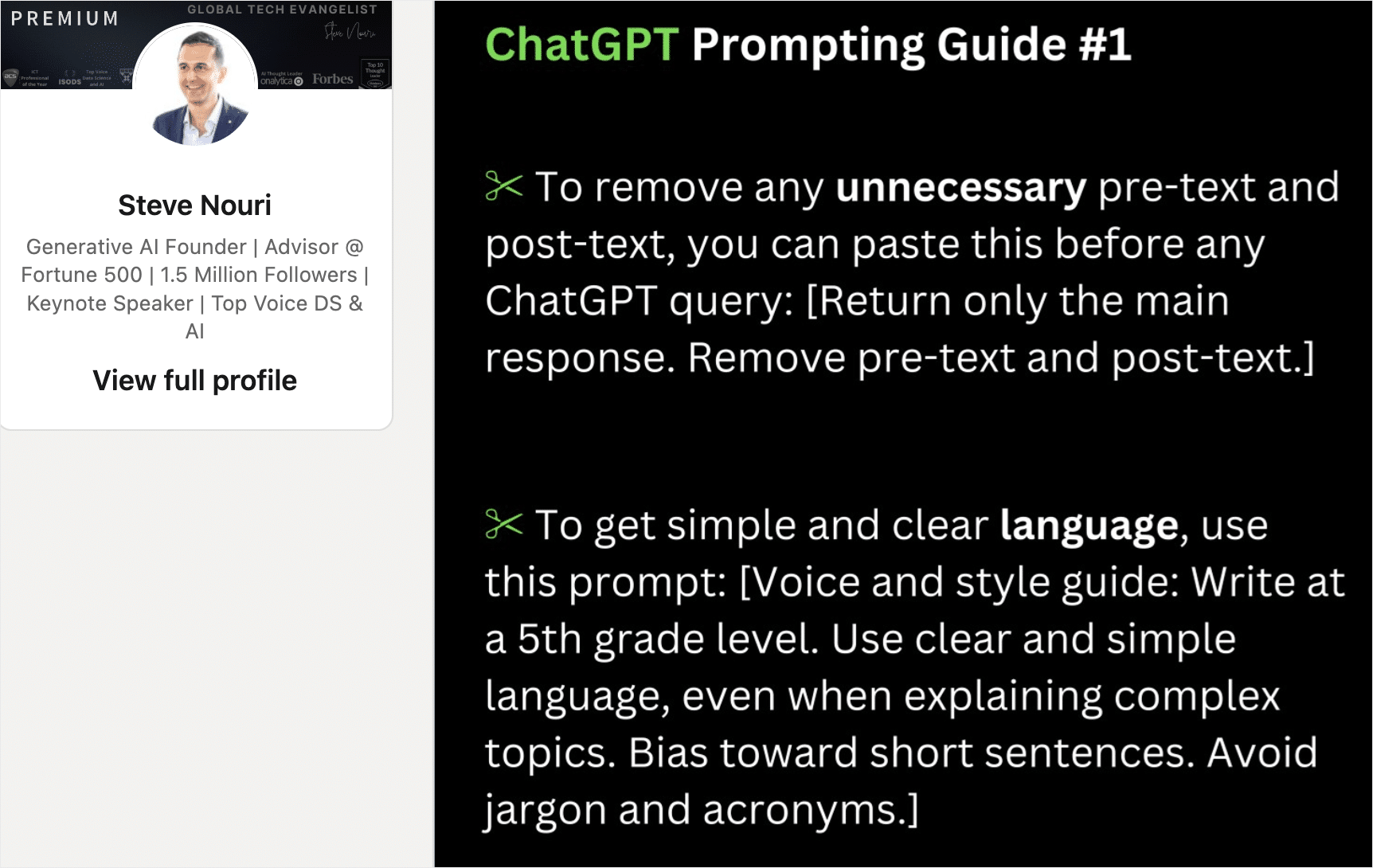
8. Limit Response Length
If you want concise answers, specify that in your prompt. For instance, “In a few sentences, explain the process of photosynthesis.” Or, if you want a 150-word newsletter, include that limit in your prompt.
Doing so can prevent ChatGPT from giving you unnecessary information. It also helps you get a response suited for the platform you want to post your content.
9. Use Keywords
If your prompt involves specific keywords or terms, include them naturally to guide the model’s response.
10. Ask for Sources
If accuracy is crucial, you can ask the model to provide sources or cite references for the information it provides.
FYI, this is where BrandWell outshines other AI content creation tools. It automatically adds sources to important facts it finds.
11. Iterate, Refine, Train
If the initial response is unsatisfactory, you can iterate and refine your prompt to provide additional details or clarify your request. This trains the model to give you better answers based on your requirements.
If the model’s response contains errors or inaccuracies, you can correct it and ask for a more accurate explanation.
With each subsequent refining of the prompt and response, the model learns how to respond better to your prompts.
12. Experiment
Don’t hesitate to experiment with different phrasings and approaches to see which prompts yield the best results. In no time, you’ll be an expert at writing effective prompts.
While ChatGPT can provide valuable information and assistance, it’s not infallible.
Always critically evaluate the responses and verify information from reliable sources when needed. This helps ensure your AI-generated content is factual and flows naturally.
Researching Blog Topics with ChatGPT
Researching blog topics with ChatGPT can be a great way to quickly generate ideas and come up with compelling content.
Brainstorming is the first step in this process, and ChatGPT can help you get started.
When you enter keywords related to your topic, the chatbot platform will generate hundreds of potential ideas you can refine and narrow down into specific topics for your blog post.
When using ChatGPT for researching blog topics, it’s important to refine and narrow down your ideas. Ask yourself questions such as:
- “What does my audience need to know?”
- “What are the current trends?”
- “How can I provide valuable insight on this topic?”
- “What kind of story could I spin around this subject matter?”
Refining your ideas and using relevant keywords when brainstorming will help you create content that resonates with readers. Additionally, using keywords related to your topic when brainstorming will ensure you come up with compelling ideas that keep readers engaged.
Once you have identified a few potential topics, use them as prompts within ChatGPT to generate more detailed questions about each one. This will help you further refine the focus of each topic so that they align with both the interests of your readership and the goals of your business—all while leveraging natural language processing (NLP) technology to ensure accuracy in understanding the intent behind user queries.
Examples of ChatGPT prompts you can use to research blog topics include:
1. “Can you suggest some unique and trending topics for a blog related to [your niche]?”
2. “I’m looking for blog post ideas about [specific subject or industry]. Could you help me brainstorm?”
3. “What are some overlooked areas within [your niche] that would make great blog topics?”
4. “Give me blog post ideas that discuss the latest developments in [industry/technology/trend].”
5. “Suggest blog post topics that provide actionable tips for [solving a common problem] in [your niche].”
6. “I aim to educate my readers about [concept/issue]. Can you propose engaging blog post ideas?”
7. “Can you help me generate blog post ideas that challenge common misconceptions in [your field]?”
8. “Provide blog post ideas that showcase inspiring success stories or case studies within [your industry].”
9. “Suggest blog post topics that compare different [products/tools/methods] used in [your niche].”
10. “I’d like to explore the future of [industry/technology/trend]. Can you give me futuristic blog post ideas?”
Remember to adapt these prompts to your specific niche, industry, or subject matter. Once you receive the generated ideas, you can further refine and expand upon them to create engaging and informative blog posts.
Finally, use these refined topics to create outlines for blog posts or other long-form content marketing material like white papers or ebooks. This allows you to identify the main points early so that all subsequent writing efforts focus on developing those key takeaways rather than getting sidetracked by tangential thoughts or off-topic musings from which little value is derived.
Researching blog topics with ChatGPT can be an effective way to brainstorm ideas, refine and narrow down topics, and generate questions that will guide your research.
Moving on, the next step of creating content outlines with ChatGPT is a great way to ensure that your content has maximum impact by identifying key points, crafting an engaging introduction and conclusion, and structuring it for optimum results.
Creating Content Outlines with ChatGPT
Creating content outlines with ChatGPT is an effective way to organize and structure your content for maximum impact. By identifying the main points of your content, crafting an engaging introduction and conclusion, and structuring your material for maximum effect, you can ensure that your readers are engaged from start to finish.
When it comes to identifying the main points of your content, consider using ChatGPT’s prompts as a guide. These prompts can help you identify key topics or ideas related to your article’s or blog post’s overall theme.
For example, when writing about marketing strategies for entrepreneurs, consider using prompts such as:
- What are three common mistakes made by entrepreneurs when it comes to marketing?
- How do successful entrepreneurs use digital marketing tools effectively?
- What tactics should be avoided when creating a successful online presence?
These prompts will help you identify key topics or ideas related to the overall theme of your article. Once you have identified these key points, you can begin crafting an outline around them.
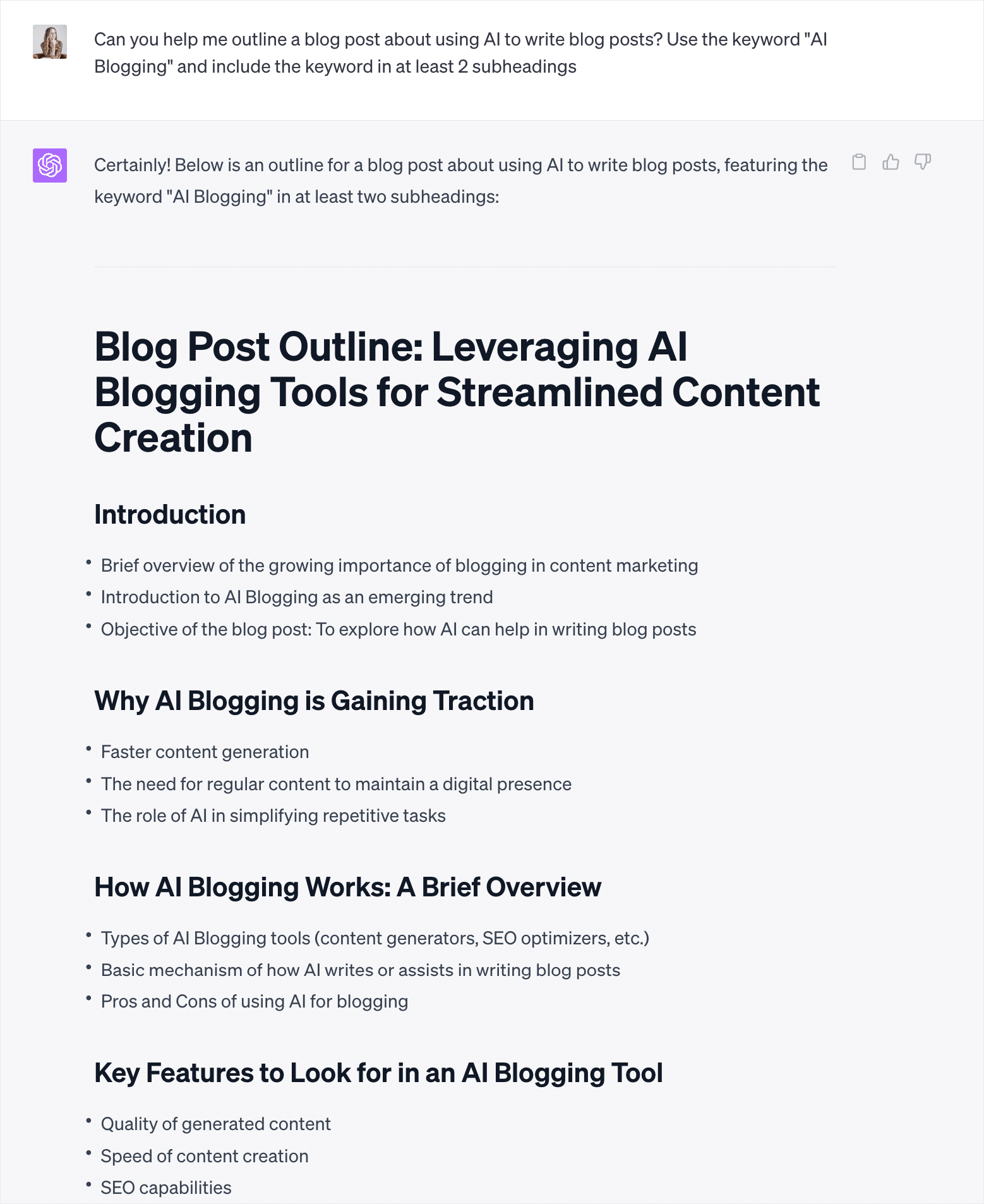
As you can see, ChatGPT produces great outlines!
Here are some prompts you can use to generate blog post outlines:
1. Can you help me outline a blog post about [topic]?
2. I need an outline for a blog post discussing [subject]. Can you assist?
3. Give me a blog post outline with key points about [theme].
4. I’m writing a blog post on [topic]. Please provide an organized outline.
5. Can you suggest a structure for a blog post analyzing [concept]?
6. Outline a blog post that guides readers through [process/steps].
7. Provide an outline for a blog post comparing [A] and [B].
8. I’m working on a blog post about [theme]. Create an outline to cover major aspects.
9. Help me outline a blog post that explains the importance of [subject].
10. Can you give me a structured outline for a blog post exploring [topic] from different angles?
The generated outlines can serve as a roadmap for your writing, ensuring you cover all relevant points and create a well-organized and coherent piece of content.
Remember, when crafting an engaging introduction and conclusion for your content, think about how best to draw in readers and keep them interested throughout the entire article or blog post. Consider using storytelling techniques such as anecdotes or case studies to make a more compelling argument at the beginning and end of each piece.
Keep it brief at the start – give just enough info so that readers understand what they’re in for before going further into the content. Finally, when crafting your blog post, use the AOFU framework to ensure your blog post converts like gangbusters.
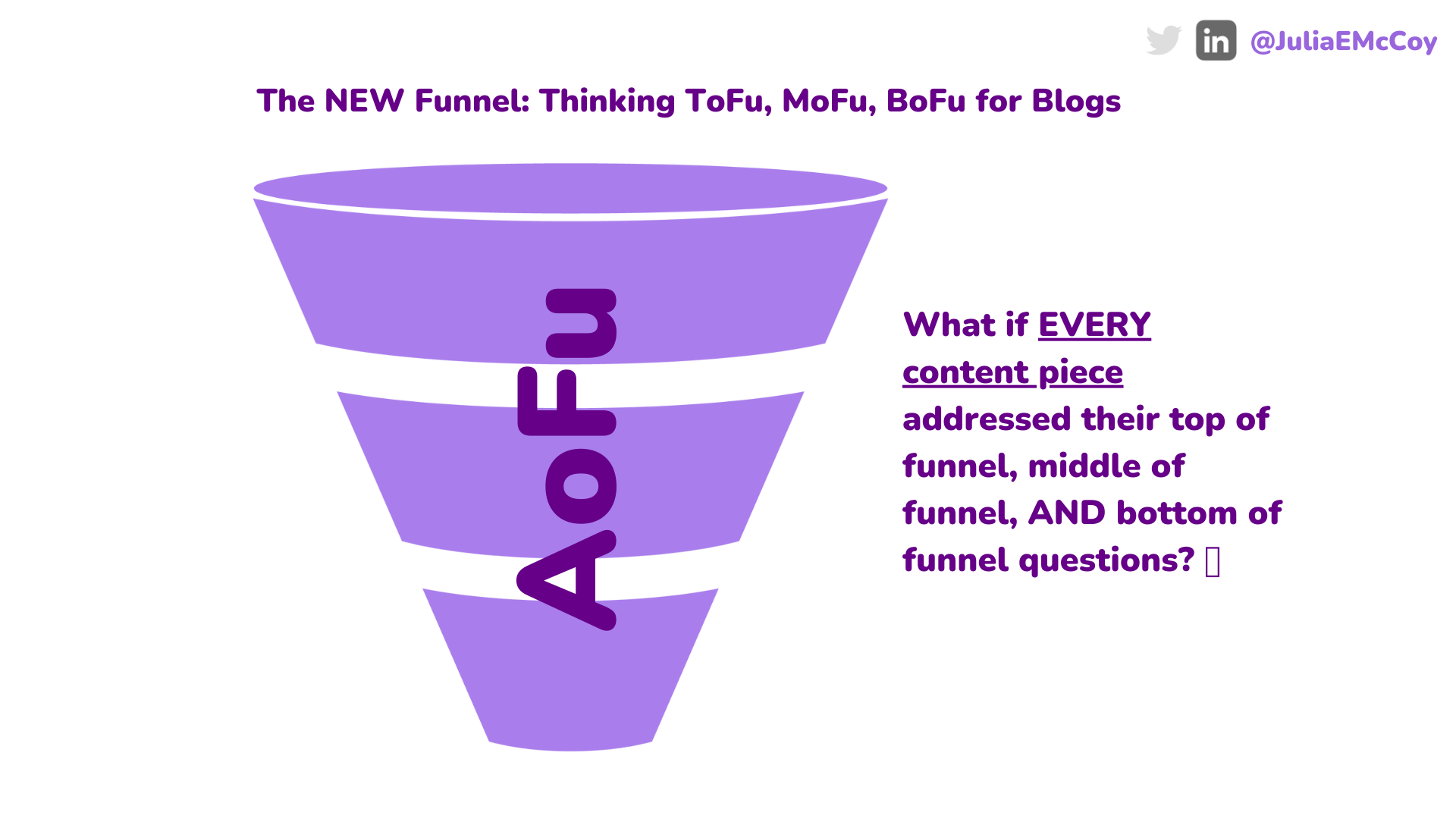
Creating content outlines with ChatGPT can help you craft engaging and impactful long-form content that resonates with your audience.
Moving on, let’s explore how to use ChatGPT to write compelling social media posts for maximum reach and engagement.
Using ChatGPT Prompts to Write Social Media Posts
For successful social media posts with ChatGPT, it is essential to first consider the correct tone and voice for your intended audience.
Depending on the platform you’re using, this can vary greatly. For example, a more casual and conversational tone may work best if you’re posting on X (formerly Twitter) or Instagram. For LinkedIn or Facebook, though, it’s often best to go for a more formal style.
Crafting compelling copy that resonates with followers is also important. Think about what they want to hear from your brand and create content accordingly.
Finally, optimizing posts for maximum reach and engagement is critical. Use keywords and relevant hashtags strategically throughout your post so it appears in relevant searches. This ensures your posts get maximum visibility.
With these tips in mind, you can create effective social media posts with ChatGPT that engage users while driving results for your business.
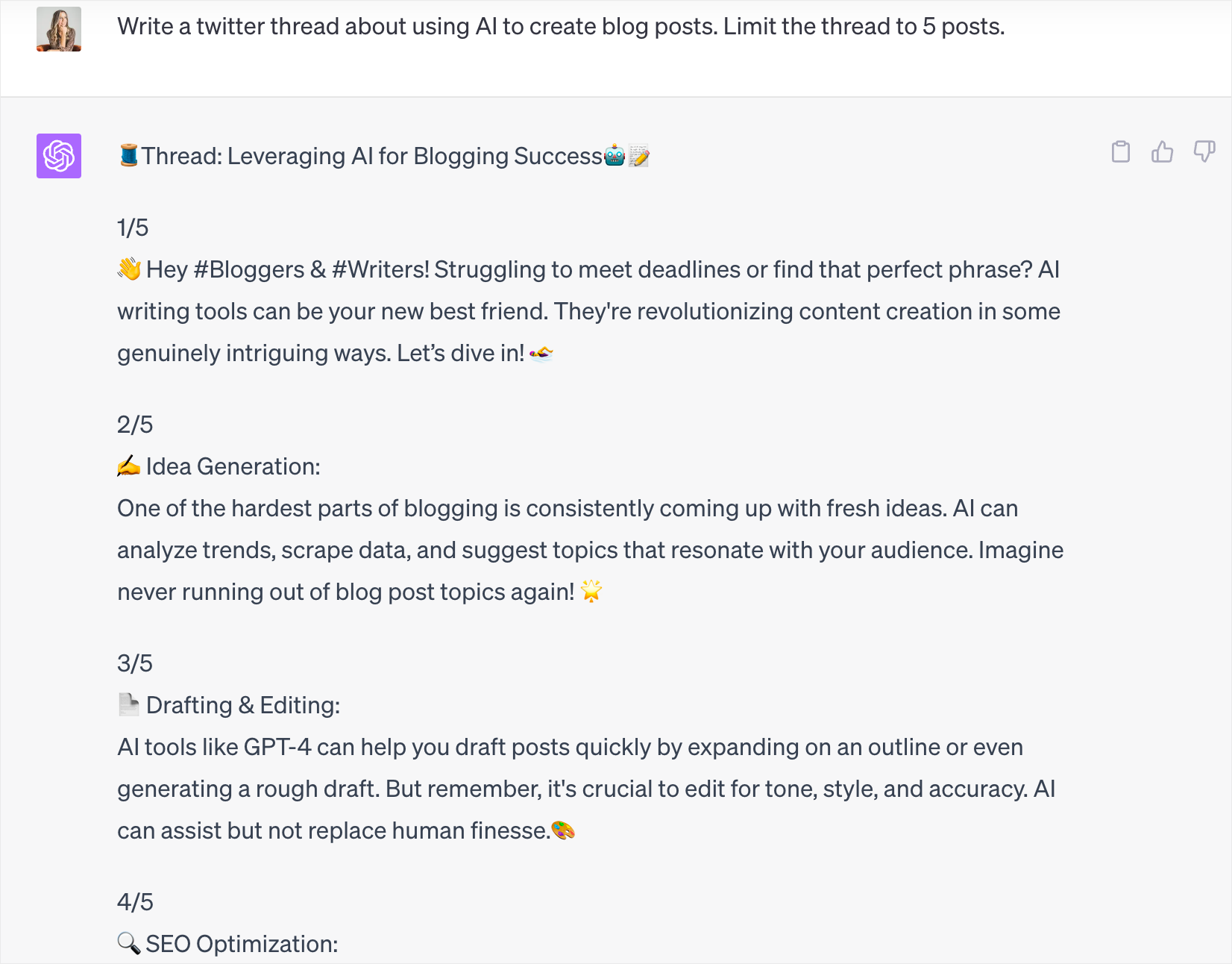
What ChatGPT prompts can you use to create social media posts?
Here are a few examples to inspire your next posts:
1. Twitter/Facebook/Instagram/LinkedIn Post Ideas:
- Create a short post highlighting the benefits of [product/service].
- Suggest a post that shares a quick tip about [topic].
- Craft a fun and informative post about [upcoming event/season].
- Generate a post that asks users to share their favorite [related topic].
2. Promotional Posts:
- Help me create a promotional post for our upcoming [sale/event/product launch].
- Write a post that announces a special discount for [product/service].
- Craft a post with a call to action to [sign up/buy/subscribe] to our [offer].
- Generate a post that encourages users to take advantage of our limited-time offer.
3. Engagement Posts:
- Suggest a post that asks followers to share their thoughts on [question/topic].
- Create a post that invites users to tag a friend who needs to see [content].
- Write a post with a poll to gather opinions on [topic].
- Craft a post that challenges followers to caption this [photo/gif] in a creative way
4. Educational/Informative Posts:
- Generate a post that shares a surprising fact about [topic].
- Create an informative post that explains the basics of [concept].
- Write a post with a quick tip for improving [relevant skill].
- Craft a post that shares an interesting statistic related to [industry/niche].
5. Behind-the-Scenes Posts:
- Share a glimpse of our team hard at work on [project/task].
- Create a post that takes followers behind the scenes of our [process/event].
- Generate a post introducing a team member and their role at [company].
6. Interactive Posts:
- Craft a post with a fill-in-the-blank prompt: ‘My favorite thing about [topic] is ____.
- Suggest a post that challenges users to guess the answer to a trivia question about [topic].
- Write a post that encourages followers to complete the sentence: ‘In one word, describe [product/service].
Remember, a good prompt must be customized based on your brand, target audience, and the specific social media platform you’re using.
Additionally, feel free to experiment with different styles, tones, and content types to keep your social media content engaging and diverse.
Creating content with ChatGPT that is carefully crafted and optimized can help ensure your social media posts are engaging and effective. Refining and editing this content further will help ensure that what you share resonates with followers while being accurate and factually correct.
Refining and Editing Content Created Using ChatGPT Prompts
ChatGPT is a powerful tool for refining and editing content. It can help identify areas of improvement, ensure accuracy and clarity, and ensure your content is easy to read.
ChatGPT’s natural language processing (NLP) capabilities let you quickly detect any errors or inconsistencies in your text before publishing it online.
You can also quickly analyze your text for grammar mistakes, typos, factual inaccuracies, word choice issues, sentence structure problems, and more. Once you have identified the areas needing improvement, you can make adjustments.
Let’s face it. Even good prompts don’t produce perfect content. You’ll still need to add a human touch to ensure your content is publish-ready.
Never rush to publish an AI-generated piece of content without first editing and refining it. This is particularly true for long-form content that relies on facts and stats to build authority.
Again, this is where BrandWell proves itself as the best AI content creation tool on the market. It produces near-perfect content that needs minimal refining. Its content generation engine is years ahead of its peers.
Sure, it’s still not 100% perfect, but you can use it to generate 2,000+ word articles in a matter of minutes. Plus, it has an SEO optimization checklist that helps you edit and optimize your post right inside the dashboard.
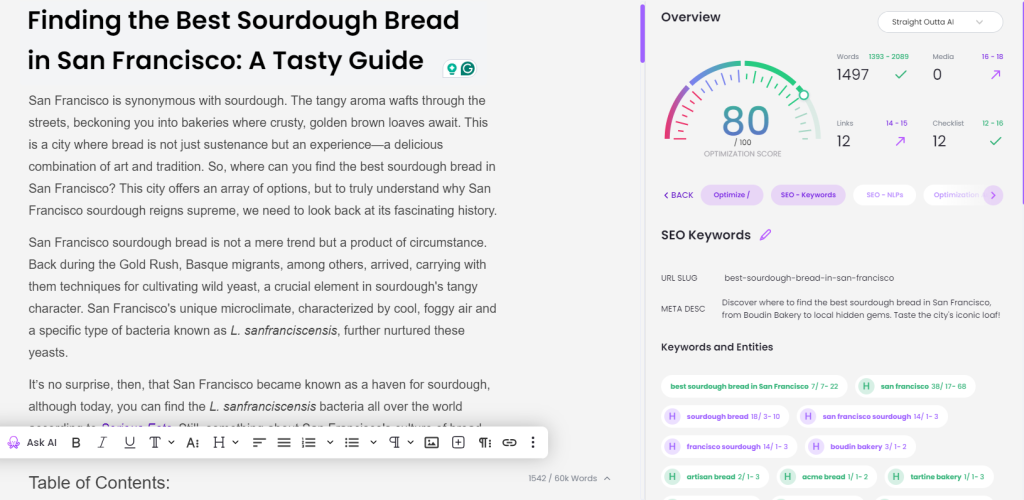
What about ChatGPT?
Sure, you can use the Chatbot platform to refine and edit your content, but it just takes longer and requires more effort. Plus, it has limitations to its databases, limiting fact-checking capabilities.
For example, you could use a prompt like, “Run a grammar check on – [insert content]” to help ensure your content is grammatically correct. But then again, that’s what tools like Grammarly were built for. 🤷♀️
Additional Resources for ChatGPT Prompts
When it comes to creating effective ChatGPT prompts, there are several additional resources that can help you come up with new ideas. By leveraging existing templates and online tools, you can quickly generate unique and engaging prompts for your audience.
Understand and Master Prompt Engineering
If you want to get the most out of ChatGPT, it will be helpful to understand prompt engineering on a basic level.
What is ChatGPT Prompt Engineering?
Prompt engineering refers to the practice of crafting well-designed and strategically worded prompts to effectively guide the responses generated by language models like ChatGPT. It involves using specific techniques to elicit the desired information, tone, style, or depth of response from the model.
The goal of prompt engineering is to enhance the quality and relevance of the generated content.
A few suggested prompt engineering tips include:
- Clarity and specificity: Clearly define your request or question in a specific manner. A precise prompt helps the model understand your intent and provide a focused response.
- Context setting: Introduce the topic or context in the prompt to give the model a clear starting point for generating the response. You can even feed the platform a piece of content whose voice and tone you want to emulate.
- Explicit instructions: Include explicit instructions about the format or style you want the response in. For example, you can ask the model to provide a step-by-step guide, an analogy, or a comparison.
- Specifying response length: You can request a response of a certain length, such as “In 100 words, explain…” or “Write a 150-word newsletter on…”. Specific commands result in better text output.
- Incorporating keywords: Include relevant keywords in your prompt to guide the model toward the specific information you’re looking for.
- Tone setting: If you want the response to be in a certain tone (formal, casual, informative), you can set that expectation in the ChatGPT prompt.
- Iterating and refining: If the initial response isn’t ideal, you can iterate and refine your prompts to better guide the model.
Prompt engineering can significantly enhance the value of your interactions with ChatGPT by improving the quality, accuracy, and relevance of the generated content. It’s a process of trial and adjustment to find the prompts that yield the best results for your specific needs.
The more you practice prompt writing, the more adept you become at eliciting the best responses. As a result, you can even simulate human conversations.
Find ChatGPT Prompt Inspiration from Other Sources
Consider looking outside the box when searching for inspiration for your ChatGPT prompts.
Check out what other companies in your industry are doing, or even look at popular blogs or social media accounts in a related field. You may be surprised by the creative ways they’re using language to engage their audiences and create interesting conversations.
Additionally, pay attention to any trending topics on social media platforms such as Twitter or Instagram that could inspire some great prompt ideas.
If you’re short on time but still want to create an engaging prompt for your audience, try leveraging existing templates as a starting point. Plenty of online resources provide pre-made templates specifically designed for creating chatbot conversations and prompting users into actionable tasks or responses within the conversation flow.
Simply tweak these templates slightly to make them relevant to your specific business needs and target audience before publishing them on your website or app.
Join Communities Built Around ChatGPT
Since ChatGPT exploded on the scene, many communities have been built around the platform. You can find these communities on almost any social social media platform.
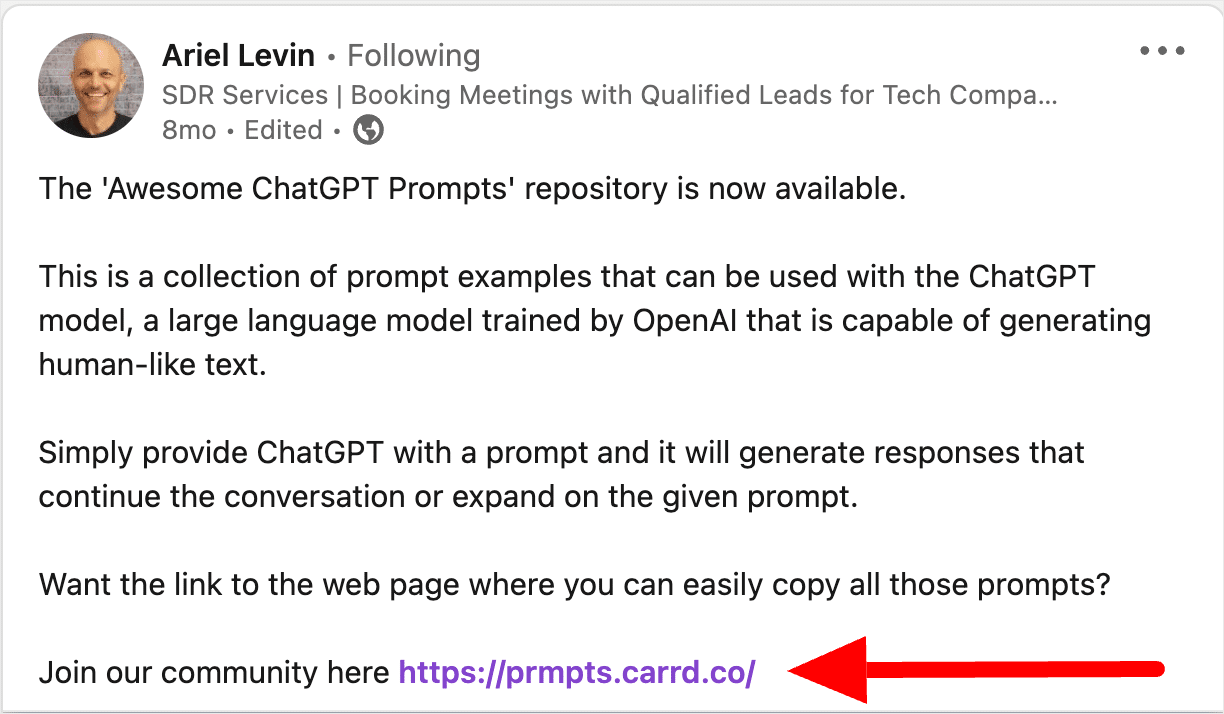
Most moderators and members of such communities have extensively experimented with AI and offer invaluable insights into how to best maximize chatbot platforms like ChatGPT. For example, you can get tips, tricks, and best practices for using the model effectively. You can learn how to optimize prompts, work around limitations, and improve the quality of responses.
At the end of the day, platforms like ChatGPT can help you generate automated content tailored to a specific topic or product category with minimal effort. This can be especially useful if you are short on time and need some quick inspiration.
But remember, for best results, master ChatGPT prompt engineering. By giving effective prompts, you can rest assured of getting better responses. This results in faster AI-powered text generation, leading to you easily scaling your content production.
You’ve Now Mastered ChatGPT Prompts, Padawan
There you have it!
Everything you need to know about ChatGPT prompts—and more!

We’ve covered all the basics and even looked at some ChatGPT prompts you can use in different scenarios.
Heck, I’ve even given you tips on prompt engineering.
With all this information, nothing can stop you from creating the best possible pieces of content in your niche. 💪
This ultimate guide to ChatGPT prompts is a great tool for entrepreneurs, founders, business owners, and marketers looking to create content quickly. You can now generate concepts faster than ever using an array of prompts tailored to your requirements.
However, don’t forget that there are plenty more resources out there with creative ChatGPT prompt ideas as well – so don’t limit yourself.